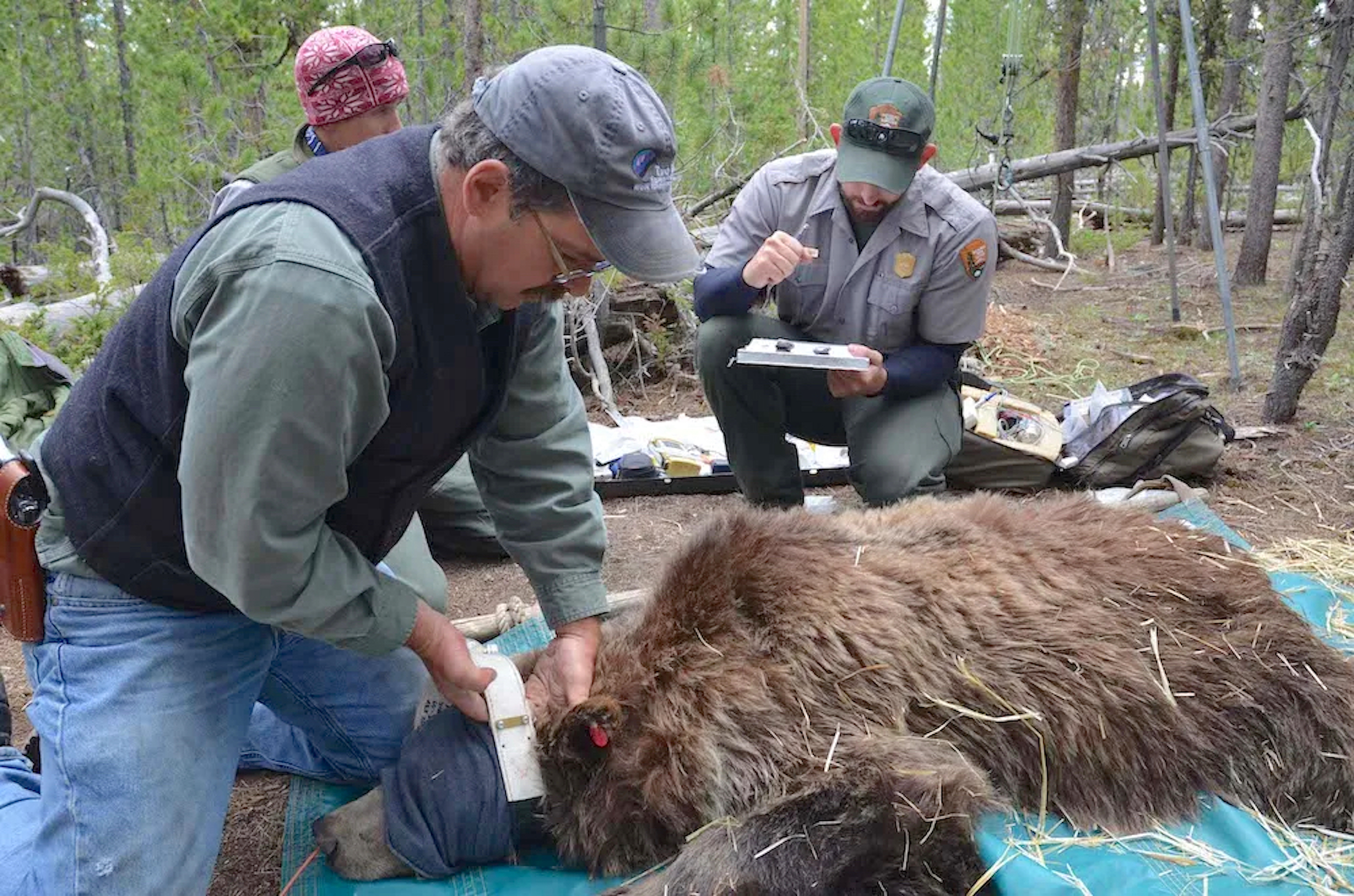Yellowstone grizzly managers — dispersed and reduced by DOGE — shine little light on delisting battle

Biologists with the Interagency Grizzly Bear Study Team fit a grizzly bear with a radio collar in 2016. Once a bear is radio collared, biologists can track its movements with telemetry. (USGS)
FROM WYOFILE:
At an ecosystem meeting, officials explain that progress and decisions about continued protections have been put on hold pending confirmation of Brian Nesvik, Trump’s nominee to lead the U.S. Fish and Wildlife Service.
CODY—Two days of discussion about the Greater Yellowstone Ecosystem’s grizzly population passed before anyone inquired about the status of the species the meeting was focused on.
Under a court order in January, the Biden administration’s Fish and Wildlife Service proposed continuing with Endangered Species Act protections in the Yellowstone region and all other portions of the Lower 48 where grizzlies reside. Shortly thereafter, pro-delisting leadership was installed by the Trump administration: Interior Secretary Doug Burgum and Brian Nesvik, a former Wyoming Game and Fish Department director who’s now nominated to lead the U.S. Fish and Wildlife Service.
For months, there’s been little official word about what’s going on with Fish and Wildlife’s proposal, though the agency delayed the deadline for the public to provide feedback. In Cody this week, the topic was barely broached at the Interagency Grizzly Bear Committee’s semi-annual Yellowstone Ecosystem Subcommittee meeting. It only came up because a member of the public, local resident Dewey Vanderhoff, asked “where we’re at in the overall picture with delisting” during the meeting’s closing minutes.
Hilary Cooley, Fish and Wildlife’s grizzly bear recovery coordinator, pointed out the proposal on the table — and said she couldn’t say much more.
“As far as what happens with that proposal, we’re waiting for leadership to be installed,” Cooley said. “Acting leadership is not interested in making decisions right now.”
As of Friday, 27 pending nominees appeared above Nesvik on the U.S. Senate’s Executive Calendar, which suggests the wait could drag on. The Trump administration also appointed another Wyomingite — mule deer advocate Josh Coursey — to a high Fish and Wildlife Service post, albeit one that doesn’t require Senate confirmation.
Even if expected Fish and Wildlife Service leaders don’t attempt to pull back the existing continued-listing proposal administratively, legislative efforts are underway to delist grizzly bears, including from Rep. Harriet Hageman.
The gathering of Yellowstone Ecosystem grizzly bear managers in Cody differed from typical meetings because of the turmoil and turnover the Trump administration has brought to the federal government via its Elon Musk-led Department of Government Efficiency. Most federal members of the committee attended remotely due to travel and spending restrictions. There were also new faces, goodbyes and discussion about what the diminished Interagency Grizzly Bear Study Team can realistically accomplish going forward.
“One way or another, the USGS is not going to have the resources they’ve had in the past,” Montana Fish, Wildlife and Parks Administrator Ken McDonald told the group. “At the November meeting, we better have a plan for the following spring.”
Biologist Matt Gould, the study team’s new leader, told the group that, despite changes in capacity, the committee’s science arm will continue with grizzly monitoring, data collection and administering the new population model to assess bear numbers — last estimated at 1,050 in the ecosystem’s core.
The Cody meeting was the last as a full-time employee for Interagency Grizzly Bear Study Team Leader Frank van Manen. The longtime federal biologist retired earlier than expected, though he is staying involved in an emeritus role. He helmed the group for 13 years.
“I know there are some challenges ahead, but keep up the good fight,” van Manen told the group. “This endeavor has been successful for 50 years, for a good reason: Agencies working together.”
WyoFile is an independent nonprofit news organization focused on Wyoming people, places and policy.
This story was posted on May 2, 2025.





